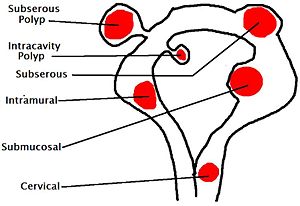Fibroids
Definition
A fibroid is a benign neoplasm of the myometrium (aka a leiomyomata).
Epidemiology
Present in 25% of women.
Pathophysiology
Growth of fibroids is dependent on oestrogen and progesterone. They increase in size during pregnancy and on the Pill but regress following the menopause.
The size of the polyps vary from millimetres to neoplasms which fill the abdomen. The three types are intramural, subserosal and submucosal. Fibroids can also form polyps which either go into the abdomen or the uterine cavity. Finally, fibroids can be found cervically.
Enlargement is often very slow. After menopause, fibroids stop growing although HRT can stimulate growth and they can enlarge mid-pregnancy. Pedunculated fibroids (fibroids with two bodies) can sometimes tort.
Risk Factors
- Approaching menopause
- Afro-Carribean women
- FHx
The following decrease risk:
- Parous women (women who have previously been pregnant)
- Previous use of the Pill (current use increases the size)
Clinical Features
Before going into the clinical features it is worth remembering that 50% are asymptomatic. Whether fibroids cause symptoms depend mostly on site rather than size (obviously a massive fibroid will be symptomatic). The main features in the history are menstrual problems and pain.
Menorrhagia occurs in 30% but timing changes rarely occur. Intermenstrual loss may occur in submucosal or polypoid fibroids. Pain can be dysmenorrhoea but generally only occurs in torsion of the fibroid.
Large fibroids can cause urinary tract problems (frequency, retention and hydronephrosis) depending on what it obstructs. Subfertility can also be a symptom as they prevent tubal patency or, with submucosal fibroids, prevent implantation.
Complications of fibroids
If blood supply to fibroids are inadequate, "degenerations" can occur. "Red degeneration" presents with pain and uterine tenderness and haemorrhage and necrosis occur. In "hyaline" and "cystic degeneration" the fibroid becomes soft and partly liquefies. Malignancy occurs when a fibroid is leiomyosarcomata (0.1-0.5% of fibroids).
Investigations
- USS
- Laparoscopy (and biopsy) (to distinguish from ovarian mass)
- Hysteroscopy (to assess distortion of uterine cavity)
- FBC - low Hb due to vaginal bleeding
Management
Small fibroids do not need treatment - the risk of malignancy is outweighed by the risk of surgery. Like many things in gynaecology, there are both medical and surgical options.
Medical
GnRH (gonadotrophin-releasing hormone) agonists can induce a menopausal state. They force downregulation in the pituitary glands i.e. by increasing the amount of gonadotrophins (FSH and LH), they reduce the number of receptors, making the pituitary less sensitive to GnRH levels. As such the pituitary does not produce FSH and LH like it usually does, inducing amenorrhoea. This in turn results in a reduction of oestrogen and progesterone production which causes fibroid shrinkage.
They should only be used for 9 months because of the main side effect of GnRH is reduced bone density. Concomitant use of HRT can allow longer administration. (HRT works against the reduction in bone density.)
Surgical
The three operations which can be done are hysteroscopy, radical hysterectomy and embolisation.
Hysteroscopy is where a camera is inserted into the uterus via the vagina and cervix. Submucosal and intracavity polypoid fibroids can be resected if causing menstrual problems and/or subfertility. Hysterectomy, removal of the uterus, can be performed or a myomectomy, removal of the fibroid, are both done via laparotomy. Myomectomy is performed if maintenance of reproductive function is desired. These are usually done after three months of GnRH agonists.
Embolisation involves occlusion of the uterine artery and has 80% success rate where hysterectomy is not desired. It can cause pain, however, and thus result in a hysterectomy to relieve this.
